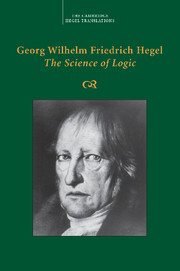Section III - Measure
Published online by Cambridge University Press: 30 September 2021
Summary
Abstractly expressed, quality and quantity are in measure united. Being as such is the immediate equality of determinateness with itself. This immediacy of determinateness has sublated itself. Quantity is being that has returned to itself in such a way that it is a simple self-equality indifferent to determinateness. But this indifference is only the externality of having the determinateness not in itself but in an other. As third, we now have the externality that refers itself to itself; as self-reference, it is at the same time sublated externality and carries the difference from itself in it – a difference which, as externality, is the quantitative moment, and, as taken back into itself, the qualitative.
Since among the categories of transcendental idealism modality comes after quantity and quality, with relation inserted in between, this is an appropriate place to say something about it. In transcendental idealism, this category has the meaning that it is the connection of the subject matter to thought. As understood by that idealism, thought is as such essentially external to the thing-in-itself.Hence, inasmuch as the other categories have the transcendental determination of belonging only to consciousness, but as its objective moment, somodality, which is the category of the connection to the subject, possesses the determination of reflection in itself in a relative sense, that is to say, the objectivity which is granted to the other categories is lacking in those of modality; these, according to Kant's words, do not add in the least to the concept as a determination of the object but only express its relation to the faculty of cognition (Cr. of Pure R., 2nd edn, pp. 99, 266). – The categories which Kant groups under modality – possibility, actuality, and necessity – will come up later in their proper place. Kant did not apply the form of triplicity – an infinitely important form even though with him it occurred only as a formal spark of light – to the genera of his categories (to quantity, quality, etc.), but only to their species to which he also gave the name of genera.He was therefore unable to hit upon the third to quality and quantity.
With Spinoza, the mode is likewise the third after substance and attribute; Spinoza defines it as the affections of substance, or as that which is in another through which it is also comprehended.
- Type
- Chapter
- Information
- Georg Wilhelm Friedrich Hegel: The Science of Logic , pp. 282 - 287Publisher: Cambridge University PressPrint publication year: 2010

